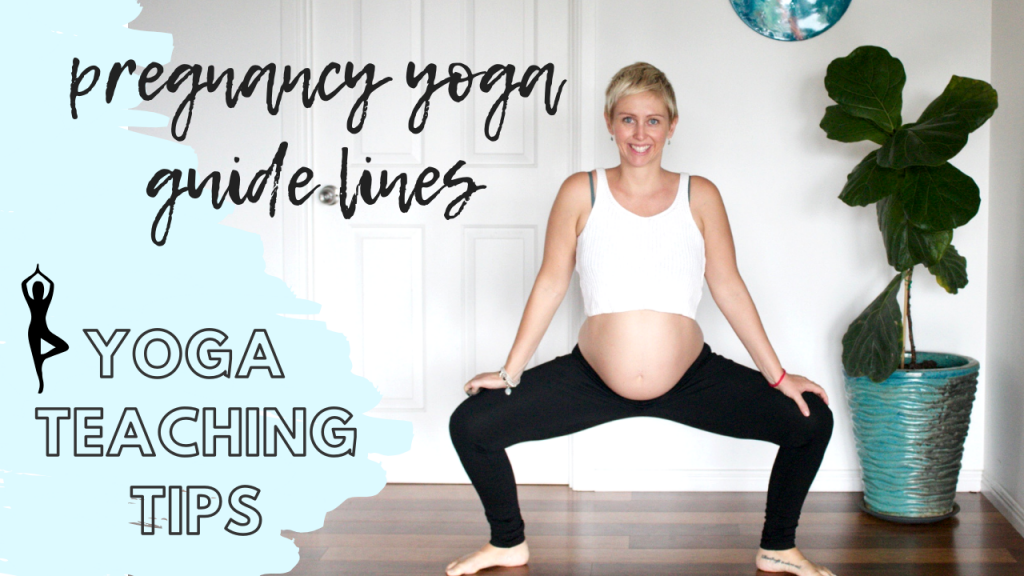What you need to know to teach pregnancy yoga
Ready to teach pregnancy yoga and wondering what you can and can’t do in a pregnancy yoga class? Or perhaps you’ve got pregnant students coming to your regular yoga classes and you’re unsure how to modify the class for them?
Stick to these safety guidelines below to make sure your classes are safe for Mums and their bumps.
Want a printable list to take with you? Download my free teaching pregnancy yoga basics guide here. Prefer to watch / listen? Scroll to the bottom for the video version.

Safety guidelines for teaching pregnancy yoga
No compression of the belly.
During pregnancy we want to avoid putting any pressure on the belly. Some women may still be comfortable lying on the belly but it is best to encourage that they don’t, as it puts too much pressure on the uterus. This means that any prone positions (lying on the belly) are obviously contraindicated during pregnancy.
Eg. Crocodile, Bow pose, Cobra, Up dog, etc
Avoid lying on the back for long periods of time.
Lying on the back from the second trimester onwards may cause compression of the vena cava (a major vein returning blood from the lower extremities and abdomen to the heart.) Pressure can decrease mother and baby’s oxygen supply and cause stress and dizziness.
As the vein runs down the right side, the effects can be reduced by placing a cushion underneath the right buttock. However for many women from around the second trimester lying on their back is no longer comfortable anyway. This position can make it difficult to breathe as the weight of the baby compresses the lungs, so avoid it where possible when you teach pregnancy yoga.
Avoid strong abdominal exercises
The abdominal muscles naturally separate during pregnancy to accomodate the uterus and growing baby. However it is important to avoid poses that require strong abdominal work as this can increase the separation and lengthen the recovery process. Gentle core work is okay (planks off the knees, tabletop, etc) and keeping an awareness of these muscles throughout pregnancy can help during recovery.
Avoid strong back bends
Deep backbends can also overstretch abdominal separation and aggravate an already compressed back. The curve of the lumbar spine is often increased during pregnancy as the weight of the belly pulls the pelvis forward. This creates an in-balance in the body and other muscles, particularly in the back which strains to hold the weight of the belly. Avoid worsening this arch by avoiding strong backbends, especially when abdominal strength is no longer there to support these poses.
No closed / deep twists
We avoid closed and deep twists during pregnancy as they create compression of the belly. Open twists are okay as long as the mother is comfortable practicing them. If any hip instability is present, twisting can be painful and you will need to modify for these students.
Avoid active inversions
We avoid active inversions during pregnancy. These poses are unsafe to practice as they require too much core strength that is compromised during pregnancy for obvious reasons.
A lack of core strength increases the chances of falling out of the pose causing injury to either mother or baby. Gentle inversions are okay to be practiced as long as the mother is comfortable. Eg. Legs up the wall, supported bridge, downward facing dog
Avoid holding poses for too long.
Due to the increased blood volume and pressure on the circulatory system you should avoid holding poses for too long in pregnancy yoga classes. Pregnant women will find long holds feel more intense than other yogis. At times, prolonged holds are used to challenge physical and mental stamina in preparation for birth, however women should always be given an alternative to move to if it becomes too much for them.
Be aware of over-exertion / over-heating.
The heart rate and body temperature are already increased during pregnancy and pushing this may cause women to feel dizzy or unwell. For this reason pregnancy yoga classes are usually gentle with short periods of challenge in preparation for managing difficult sensations during labour. Encourage pregnant women to rest whenever they need and drink water to cool the body down if needed.
Move from lying, seated or head down positions to upright – slowly.
As the centre of gravity and blood pressure changes, moving too fast can cause dizziness and some women may lose their balance. In addition, some women may feel very awkward in their body as their belly grows large. Moving slowly from low to high positions (and vice versa) helps women to gain more confidence in their body and not feel unable to keep up with the class.
Encourage women to not overstretch
During pregnancy the hormone relaxin is released into the body to allow the pelvis to open for the baby to grow and move through during birth. This relaxin loosens the ligaments that support the joints in the body and puts them at greater risk of injury if they push too hard during stretching poses.
The main concern is opening the pelvis too much which causes instability and results in painful conditions like Symphysis Pubis Disfunction and Sacroilliac pain. It is important that women understand that sometimes hip openers can feel incredibly good but moving in too deep can cause issues later on. This is especially common amongst women who were already considerably flexible pre-pregnancy like yoga teachers, dancers, gymnasts, etc.
These are the main considerations to keep in mind when you teach pregnancy yoga. However all women and all pregnancies are different. Your students may present to class with a wide range of different conditions and experiences.
If you’d like to learn more about teaching pregnancy yoga I recommend signing up to my prenatal and postnatal teacher training program
